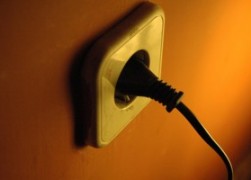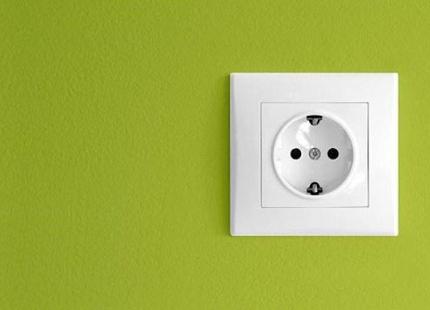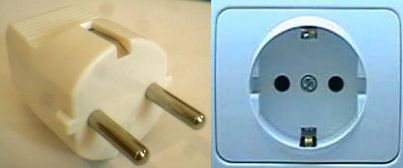Categories: Electrician at home, Sockets and switches
Number of views: 201266
Comments on the article: 25
What to do if spark plugs
 Why does the outlet sparkle? And the socket can glow. An uneven, twitchy, but rather bright light. But this light does not inspire others with any optimism and does not create any festive mood.
Why does the outlet sparkle? And the socket can glow. An uneven, twitchy, but rather bright light. But this light does not inspire others with any optimism and does not create any festive mood.
On the contrary, in people far from electrical engineering, such light causes superstitious, almost primitive fear. Almost like before thunder and lightning from our ancestors. Especially since nature sparking in the outlet the same as that of a lightning discharge of atmospheric electricity. And even “thunder” is present - in the form of dry cod.
It may, of course, not be afraid, but it is still worth fearing a sparkling outlet. And to remain indifferent, if such a "fun" outlet wound up in your apartment, it should not be. The temperature of the electric arc, which are the outlet sparks, reaches thousands of degrees. And this not only negatively affects technical condition of the plug and socket, but in general can lead to a fire.
But before you solve the problem, you need to understand the causes of its occurrence. So, we list the possible causes of sparks in the outlet and ways to eliminate this phenomenon.

1. The outlet sparks due to mismatch between the plug and the outlet according to the standard.
Not everyone knows that in the territory of the former USSR two standards are common for the execution of electric plugs and sockets: Shuko and Soviet (C). The Soviet standard is now dying and a thing of the past. These standards differ in the design of the plug and socket, but the most important difference is in the diameter of the plug electrode.
Shuko forkinstalled on the vast majority of modern household appliances and on power toolhas electrodes with a diameter of 4.8 mm.
Shuko standard plug and socket
The Soviet standard plug has an electrode exactly 4 mm in diameter. But the distance between the electrodes is the same for both standard plugs. The result is that people, without giving any significance to the difference of 0.8 mm, combine plugs and sockets of different standards. And if it is difficult, but you can drive the Shuko plug with a reliable electrical contact into the Soviet standard socket, then problems with the reverse combination are inevitable.
A slender plug with thin electrodes cannot be securely installed in a Shuko socket, the electrical contact will be weak, and the interface between the plug and the socket will spark even under minimal load. Moreover, at first everything will cost only a slight sparking, and in the future it is even possible to melt the body of the socket and plug.
The way out of this situation is this: it is necessary to ensure that the plug and socket always match each other according to the standard. And if you are already unlucky, and you have already ruined one plug pair, then you just have to replace it. There are no other options.
2. The outlet sparks due to overcurrent.
This is perhaps the most common reason for the failure of outlets. In fact, the rated current of the outlet is always given on its plastic case. But the trouble is that for most ordinary people, these amperes with numbers are not more understandable than any nodular letters of the ancient Incas. But there is no question at all about correlating these amperes with kilowatts of power of connected household appliances.
Therefore, it is often connected to a single outlet through a tee or extension cord for several powerful power consumers (why it is dangerous to use tees and extension cords) The current in the outlet can exceed the rated current several times, especially if the outlet is weak. At the same time, the contacts of the outlet begin to heat up, their resistance increases, the temperature increases even more ... It turns out a real vicious circle, and the result is the same again: sparks, flames, molten socket and plug and, possibly, even a fire.
To avoid this situation you need to monitor the degree of load of sockets. For orientation purposes, we present the ratio between the current ratings of the sockets and the ultimate power that they can provide: 220 watts per ampere. Respectively, for a 16 amp socket, the maximum switched-on power will be approximately 3.5 kW.
An overloaded extension cord often causes sparking in outlets due to overcurrent
Do not flatter yourself and think that a double outlet is twice as powerful as a single. The rating shown on the outlet is common to all of its plug connectors.
If your outlet began to spark due to overload, then it most likely cannot be helped anymore - it must be replaced. How to install a power outlet - detailed photo instructions for installing power outlets.
3. Deteriorated plug sockets.
This happens when the plug is often pulled out and reinserted. The clamping jaws weaken and cannot compress the electrodes with sufficient force. The result is a weakening of the contact and heating.
If such a phenomenon is noticed on time, the outlet can be saved (how to fix an outlet) Then it is necessary to disassemble, otrevizirovat and tighten her lips with pliers for more tight contact.
4. Loose screw terminal.
This is especially true for sockets powered by aluminum wires. Aluminum by itself, over time, "flows out" from under the point of contact, so screw connections with aluminum must be tightened from time to time. See more about this here - Why aluminum cable cannot be used in electrical wiring.
If this is not done, the contact of the wire with the socket of the outlet will deteriorate, arcing will occur, which will intensify when you touch the plug. You cannot start this position - it is better to service screw connections in a timely manner.
Conclusion.
Whatever the cause of the spark in the outlet, this is a sure sign that there are problems with it. Turning a blind eye to this is simply dangerous. At the same time, a timely response to sparking in a power outlet will help not only to avoid a fire, but also possibly save the power outlet, plug and even your household appliances.
Alexander Molokov
See also at i.electricianexp.com
:


